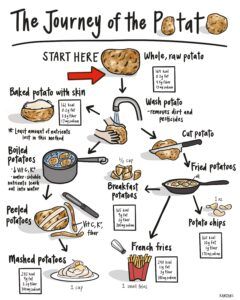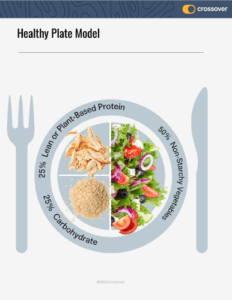
Nutrition and Cooking
Whether you’re a bonafide foodie or totally confused about all the conflicting “eat this, not that!” nutrition advice, Crossover can help you optimize your diet and build healthy eating habits that are satisfying and sustainable. Discover what different foods can do for you and how to build nourishing meals that have balance, flavor, and variety.
Learn. Find the tips that fit your situation.
Practice. Choose from helpful strategies.
Let us help. Connect with your Crossover care team.
Expert Guidance Along the Way
-
Linda Wu, LAc, DACMAcupuncturistLinda loves working with people and feels honored to practice medicine that improves the body and mind. She is also excited to work in an integrative setting at Crossover Health, where providers collaborate to support members in achieving their health goals.
-
Maxine Yeung, MS, RDHealth CoachMaxine works in healthcare because it's exciting and ever changing. There is always something interesting to learn and she loves having the opportunity to spread this information and help others feel empowered too.
-
Elizabeth Aong, MPH, RDHealth CoachElizabeth believes in the power of nutrition's influence on our wellbeing and quality of life. She feels fortunate to be in a role where she gets to see members transform by working on behavior change over time.
At Crossover, we believe that health is a lifelong journey, not a destination. We also know that health includes many factors: physical health, mental and social well being, life satisfaction, and the way your culture views health. Your healthspan is the amount of time in your life that you spend in good health, and at Crossover, we want your healthspan to be as long as possible. Watch the video below for more info on how we define health and all the ways we can help you extend your healthspan.
What is Health?
With Crossover’s definition of health in mind, you might now be wondering how this applies to healthy eating. It seems everyone has something to say on this topic, from health professionals and influencers to your neighbor who lost 10 lbs. Often, “healthy eating” information can be rigid, misleading, and sometimes downright scary. The two videos below provide a clear definition of healthy eating, as well as some tools you can use to make healthy eating a joyful, balanced habit.
What is Healthy Eating?
Tools for Healthy Eating
The table below contains different categories of foods and beverages and lists their types, functions in the body, facts about their benefits, and ideas for how to incorporate them into meals and snacks. We believe that all foods fit and also that some foods fit best when consumed in moderation. You’ll notice under the ideas sections that we list all kinds of foods, even those that are best consumed in moderation. The ideas section is to help spark creativity, not as a guide on what to consume daily.
| Beverages | Types:
Function:
Facts:
Ideas:
|
| Dairy | Types:
Function:
Facts:
Ideas:
|
| Dairy Alternatives | Types:
Function:
Facts:
Ideas:
|
| Dessert | Types:
Function:
Facts:
Ideas:
|
| Fats | Types:
Function:
Facts:
Ideas:
|
| Fruit | Types:
Function:
Facts:
Ideas:
|
| Grains | Types:
Function:
Facts:
Ideas:
|
| Legumes (Beans & Pulses) | Types:
Function:
Facts:
Ideas:
|
| Meat Alternatives | Types:
Function:
Facts:
Ideas:
|
| Nuts & Seeds | Types:
Function:
Facts:
Ideas:
|
| Poultry | Types:
Function:
Facts:
Ideas:
|
| Red Meat | Types:
Function:
Facts:
Ideas:
|
| Seafood | Types:
Function:
Facts:
Ideas:
|
| Soy | Types:
Function:
Facts:
Ideas:
|
| Spices, Herbs, and Seasonings | Types:
Function:
Facts:
Ideas:
|
| Sugar (Added) |
Types:
Function:
Facts:
Ideas:
Wondering about low calorie sweeteners like stevia, sucralose, and aspartame? They are usually sweeter than sugar and are typically used in smaller amounts, providing little or no added sugar or calories. While most low calorie sweeteners are generally regarded as safe by the FDA, they are not entirely without risk and should be used with the same level of moderation and care as regular sugar. |
| Vegetables (Non-Starchy) |
Types:
Function:
Facts:
Ideas:
|
| Vegetables (Starchy) |
Types:
Function:
Facts:
Ideas:
|
”Processed” often has a negative connotation, and it might surprise you to know that there really isn’t a standard definition of “processed” when it comes to food. Simply put, processing just means altering a food from its natural, raw state. Processing can be done in a lot of different ways, and not all of them drastically change the nutritional content. For example, pre-washed and pre-cut fruit is technically a processed food, but the nutritional benefits of the fruit are not affected or reduced.
As an example of all the ways a single food can be processed, look at the graphic below. As you can see, processing a potato in different ways results in many different products and dishes with a wide range of nutritional profiles.
It’s great to learn about different categories of food and their health benefits, but what do you do when it comes time to make a meal? As you can see in the picture below, a healthy plate is made up of ½ non-starchy vegetables, ¼ plant or lean protein, and ¼ carbohydrate. It looks something like this:

To learn more about the Healthy Plate Model, take a look at this handout:
What happens, though, when your plate is a sandwich? Or a bowl? Or a to-go cup while you’re running out the door to work? The section below gives you real-life examples of how to put together balanced and delicious meals and snacks when you’re eating from something other than a plate.
When Your Plate Is a Noodle Bowl:
When Your Plate is a Noodle Soup:
When Your Plate is a Sandwich:
When Your Plate is Breakfast:
When Your Plate is a Smoothie:
When Your Plate is a Taco:
Like anything related to nutrition and food, there is no one-size-fits-all approach. If you are very physically active, have high energy demands, or are eating for a specific purpose or condition, your eating plan may look different than the eating plan of someone trying to lose weight or build muscle. A dietitian or health coach can help you identify your unique goals and needs and develop an eating plan that’s right for you.
Now that you’ve learned all about food categories and how to put a balanced meal together, you’re ready for recipes. We’ve pulled together some of our favorites to help you put your nutritional knowledge into practice! Come back to this section periodically to see new recipes to try. Bon appetit!
Your Crossover care team is here to help. We have coaches who can make a plan so you know where to start. Our mental health team can talk you through your stress and anxiety. Our physical therapy team can help you recover from injury with safe movement. Or you can start with a physical for a full picture of your overall health. Wherever and whenever you’re ready to begin, just connect with your Crossover care team. We want you to be well.

























